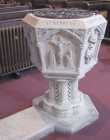For this church:    |
Cinderhill Christ ChurchFeatures and Fittings
|
| Inscription | Depicting | |
| Johannes | St John in the wilderness | |
| Thomas | Christ showing His wounds to St Thomas | |
| Woodhouse | A rebus representing Noah’s Ark (wooden boathouse) | |
| Hunc fontem dedicavit | Kneeling figure of Mr Woodhouse who gave this font | |
| Domino nostro | Our Lord, shown on the Cross with two Marys kneeling either side | |
| Deo Gloria |
Above each panel are the titles in Greek from designs made by the Rev E R Pitman, brother of the Rev H R Pitman, Vicar of Basford. These and the font itself were made by Osmond and Son, sculptors, Salisbury.
Pulpit
The first pulpit installed in Christ Church was made of Ancaster stone. It was designed and carved by the Nottingham-trained sculptor Thomas Earp who, by this time, was working in London. He went on to carve figures of Robin Hood and his Merrie Men on the front of Bestwood Lodge. This pulpit stood at the opposite side of the nave from the present one.
A full description of it is given by W W Fyfe:
The sculptures let into the pulpit of Ancaster stone, by Earp, of London, are worthy of admiration - on the chancel side bearing a deeply, freely, and beautifully relieved figure, a combination of the dove and star in superb elaboration - on the pulpit front the centrepiece being the religious anagram of the Agnus Dei, the Lamb and Banner, with gorgeous clusters of surrounding maple foliage, alternated at the angles of the stone panel with a beautiful and appropriate series of emblematic sculptures, viz., the man, the winged lion, the eagle, the winged bull, the typical characteristics of SS. Matthew, Mark, Luke and John. The pulpit slab or desk is in part sustained by an angel with outstretched wings, bearing a ribbon, on which is a script inscribed, “Preach the Word” and on the side of the pulpit next the wall is the sacred monograph, “I.H.C.” reposing on an enrichment of foliage in relief, the leaves maple and vine commingled. The basement of the pulpit is ornamented with running tracery of quatrefoils. The projecting trusses at the angles are sustained by corbels of sculptured angels, the exterior jambs being elegantly enriched by diapered sculpture. The cornice moulding terminates on either side in a sculptured boss. From all this it will be seen that the pulpit is covered over with rich and costly sculpture.
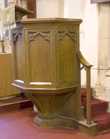 The
current pulpit The
current pulpit |
Earp’s pulpit crumbled badly and had to be removed and replaced in 1957.
Originally the present pulpit was on the same side of the nave as the lectern. This is because it was installed before the old pulpit had been removed. It is of plain oak, tulip shaped and pentagonal. It bears a brass plaque:
| Given in Loving Memory of George Vickers, churchwarden, verger and
secretary of P.C.C., died November 17th 1956. |
Reredos
The original reredos in 1856 was composed of Minton tiles ‘presenting the very unique and most beautiful effect of brilliant Mosaic work ...’. Nevertheless about fifty years later it was covered over by the present one in wood, more ornate and richly carved and painted.
 Panel
of St Matthew Panel
of St Matthew |
 Panel
of St Mark Panel
of St Mark |
When the side chapel was constructed in the north aisle in 1965 four panels bearing the symbols and Latin names of the four Evangelists were removed from behind the high altar and placed on the north wall.
 Looking into the chancel, Looking into the chancel,showing the screen |
Rood Screen
The dark oak rood screen and rood were erected in March 1925, probably made by Henry Barker, Smart & Brown. Carved on the screen are the names of the Chaplain at that time, W J Toleman and the Churchwardens. It cost £180 15s 0d.
Altar rails
The original brass rail was made by Rhodes of Wollaton Street, Nottingham. In January 1949 it was replaced by an oak rail in memory of those from the parish who died in the Second World War. It was dedicated by the Rt Revd Bishop J R Weller, as recorded on a plaque.
Pictures
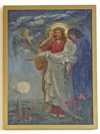 Christ
with Attendant Angels
Christ
with Attendant Angels
This imposing oil painting, which is well over six feet in height, hangs above the south door. It was painted in 1900 by a local businessman and artist called William Bramley, who gave it the title ‘Christ with Attendant Angels’. Christ is showing concern as He surveys the landscape around Cinderhill which appears to be marred by collieries and factories. Apparently the faces of the angels are based on those of local people. The painting was restored mainly by a grant from the Council for the Care of Churches.
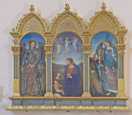 The
Triptych The
Triptych |
 The
plaque beneath The
plaque beneath |
The Perugino Triptych
These three pictures form a triptych which hangs on the west wall of the nave. They are reproductions of paintings by Pietro Perugino (1446 - 1523), an Italian painter of the Umbrian School. The originals hang in the National Gallery in London. The central picture is of the Virgin Mary and Child; on the left is the Archangel Michael and on the right is the Archangel Raphael and Tobias. The triptych had a gilded frame and is behind glass. Beneath it is an oak plaque:
IN LOVING REMEMBRANCE OF “Them also which sleep in Jesus |
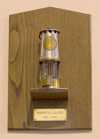 Miners’ Lamp
Miners’ Lamp
There is a miners’ lamp, an acknowledgment of Babbington Colliery (1842-1986) which was one of the most important features of the community of Cinderhill.
It is appropriately situated beneath the memorial to Thomas North.


